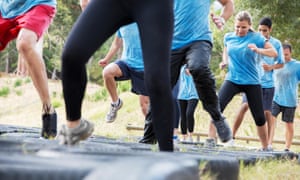Why would anyone want to run 400km across a desert? It’s a good question and one that I confronted last year when I completed the Ultra Gobi, a single stage, self-navigated 250-mile footrace in China. This year I face an even harder question: Why would anyone do it again?
In moderation, running improves both your health and physique; in extremes, it does quite the opposite. The feet blister and swell to the point where multiple pairs of shoes in ascending sizes are required. Toenails turn black and fall off or, worse, fill with fluid and require puncturing. Some runners even choose to strike pre-emptively and have theirs surgically removed.
Stress fractures are customary. Tendons rub and become enflamed, sending shooting pains up the leg with each agonising step. Muscles seize up, cramp unpredictably and eventually wither away, leaving a gaunt and haggard appearance. Clothing and pack straps rub the skin raw and bloody.
The stomach often ceases to function, leading to vomiting or diarrhoea – a serious issue when one needs to drink 10 litres of water and eat upwards of 6,000 calories each day.
But the greatest effect is less visible: the mind, addled by lack of sleep and constant battles with the body, begins to lose its grip on reality. Hallucinations are common. Emotions can oscillate from elation to anger to melancholy in rapid succession. Speech becomes slurred; planning, rational decisions and accurate navigation almost impossible.
It is not, by any conventional definition, pleasurable. So, why then, are increasingly numbers of people paying good money to put themselves through it?
Fortunately, this is a question that academics at the University of Cardiff have sought to tackle. Published in the
Journal of Consumer Research, their research confronts the seeming conundrum that, on one hand, consumers spend billions of dollars every year to alleviate different kinds of pain, while, on the other, millions of individuals participate in extremely painful leisure pursuits.
The paper’s title, Selling Pain to the Saturated Self, implies a key premise: that, unlike many sports and activities, where pain is a risk to which participants are prepared to subject themselves, in endurance sport pain is a core part of the appeal. Even a brief conversation with most ultrarunners is enough to confirm this. Races are reverentially described as “brutal” and “savage”, and suffering is discussed with gleeful awe. Similarly, the marketing of many races highlights the opportunities for pain that they are, in effect, selling.

Although the research study technically focuses on assault-course racing (the lead researches using her body “as a tool for inquiry and knowledge creation”) rather than ultramarathons, the three leading motivations they uncover are equally transferable.
Firstly, pain makes us more aware of our own bodies – or, in the study’s terms, enables us “to rediscover our corporeality…through sensory intensification”. In a world where our bodies have largely ceased to be useful tools for survival and instead merely act as receptacles, it is perhaps little surprise that some form of disconnect has arisen. For the frustrated, sedentary office worker, sensory intensification – be it through self-inflicted pain or stimulatory drugs – presents an opportunity to bridge this dualistic divide. In the Gobi desert in 2016 I certainly felt much more aware of my own body as it gradually disintegrated.
It follows that the popularity of ultramarathons is closely linked to the comfort of modern life. Try explaining to people whose lives are physically uncomfortable by necessity that you run in circles for pleasure, and you receive a blank look of confusion. China meanwhile, with its exploding middle class, is witnessing and unprecedented growth in endurance running.
Secondly, there is a degree of mental escapism. As the authors, somewhat morosely, put it, “by flooding the consciousness with gnawing unpleasantness, pain provides a temporary relief from the burdens of self-awareness”. Escaping from self-awareness would appear to be a common characteristic of the human condition. Alcohol tends to be our society’s favoured fix, although binge-eating, antidepressants and ultimately suicide are also associated problems. In this context, ultramarathons begin to look quite benign.
It also helps to explain the abundance of recovered addicts and depressives in the sport, many of whom, as discussed by the famous American runner Nikki Kimball, use running as a form of therapy. And there are many others, myself included, who fear that without ultrarunning they might have been more susceptible to other, more damaging, forms of escapism.
Finally, the authors assess the role that painful experiences play in retrospect. Pain helps people “craft the narrative of a fulfilled life through wounds and scars”. As a runner and occasional writer, that statement is as depressing as it is true. Samuel Johnson once said that “every man thinks meanly of himself for not having been a soldier”. Ultrarunning can provide ideal faux-battle wounds to remedy that feeling. Some runners even motivate themselves during races by pretending to be fleeing the Gestapo, or the Burmese military, or another genocidal enemy.
In reality, ultramarathons are lonely, arduous and largely uneventful. As a spectator sport they are marginally better than England football friendlies, but not quite as good as Jenga. And yet, through social media and blogs, they are dramatised into heroic struggles and atheist pilgrimages, a transformation that is reinforced by the well-intentioned, if misguided, puritanical attitude that perseverance is, by its very nature, worthy.
Overall, the paper presents a somewhat bleak but probably quite accurate assessment. I’m left not entirely sure whether my return to the Gobi is an attempt to escape the futility of existence or to find purpose through pain, to discover or forget, a therapy or a drug, self-harm or self-help … or all the above. I am, however, thoroughly looking forward to it.
You can follow the progress of the Ultra Gobi from 27 September here and on Instagram @jogonalfie
Source: Read Full Article
